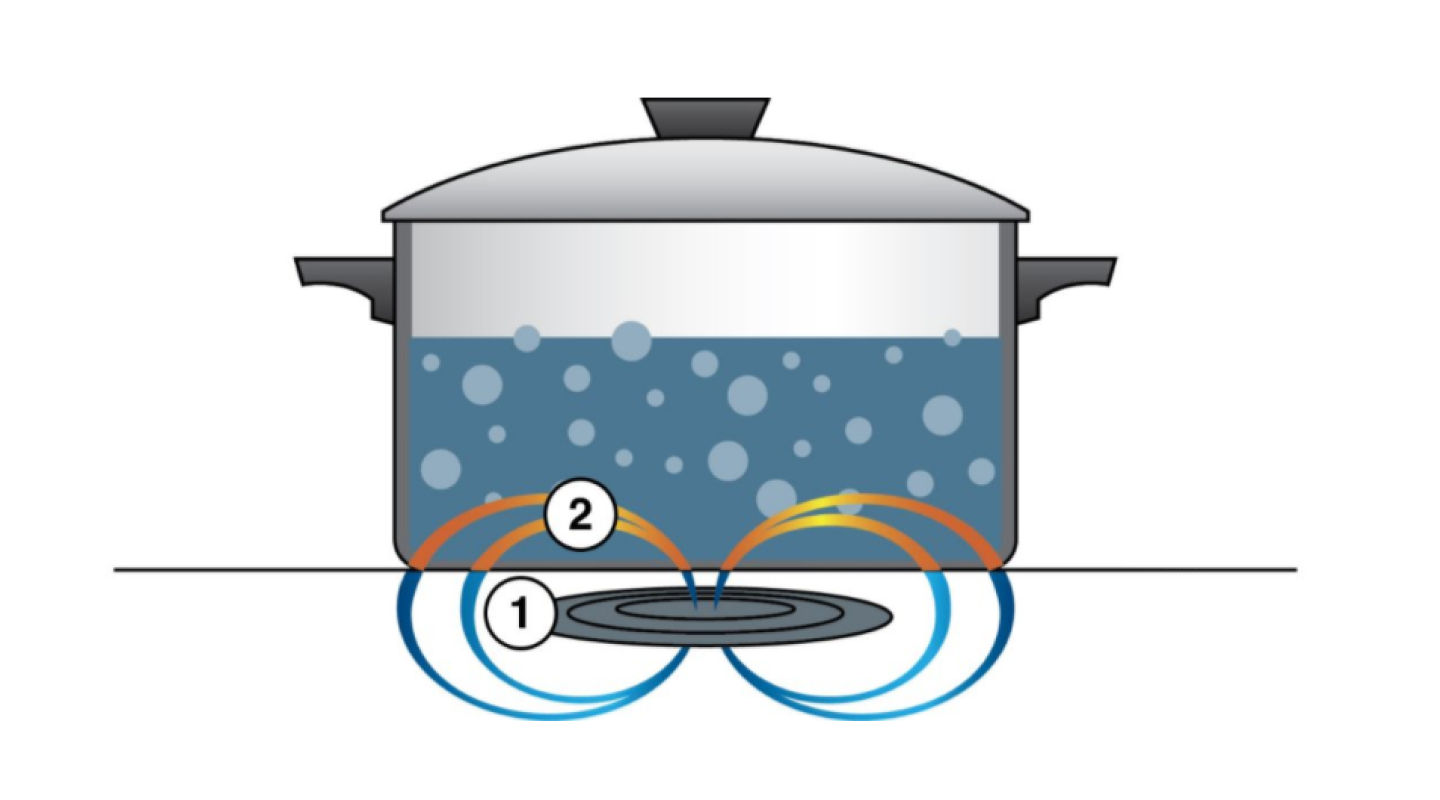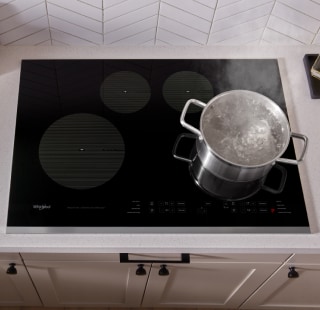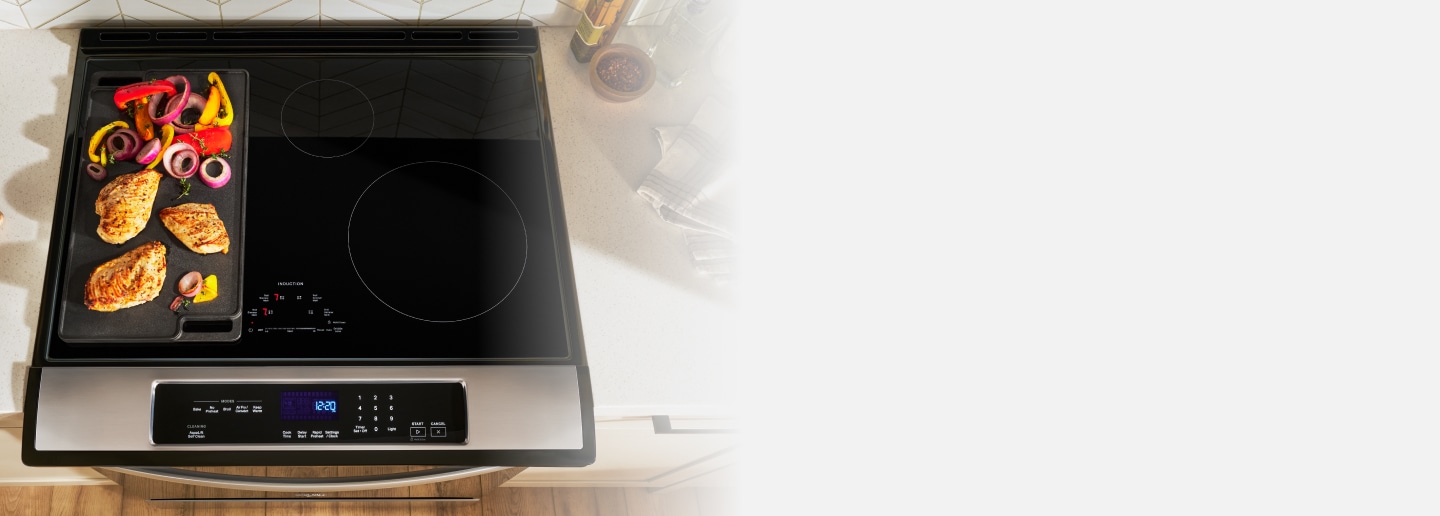
What is induction cooking and how does it work?
Though popular in Europe for years, induction cooktops have become increasingly popular in the United States as people look for more energy efficient cooking options. Unlike more traditional types of cooktops, induction cooktops rely on electromagnetic energy to directly heat cookware, which can lead to faster changes in temperature and help improve cooking efficiency.
Use the following guide to learn more about induction cooking and its benefits.

How does induction cooking work?
While induction cooktops and ranges may look like traditional cooktops or ranges, the way they generate heat to cook food is entirely different. Induction cooking uses a copper coil underneath the cooking surface to generate electromagnetic energy. This energy transfers directly to induction-compatible cookware to make it hot.
This method differs from electric cooktops, which use infrared energy to apply heat indirectly to a pot or pan via a heating element, and gas cooktops, which require a gas line and use an open flame. Induction cooking can offer the best of both worlds: the sleek, simple-to-clean surface of electric cooktops combined with the accuracy and control of gas.
Whether you choose an induction, gas or electric cooktop, Whirlpool brand has a variety of options to fit your kitchen’s needs.

Is induction or electric cooking right for you?

Tips for using cast iron on induction cooktops
Benefits of induction cooking
Induction cooking has many benefits that can simplify cooking and give you extra time with family. Fast heating times and temperature adjustments, as well as simple cleanup can make induction cooking an appealing option for many households.
As for the professionals, do chefs prefer gas or induction? It depends who you ask. While there are chefs who declare they will never switch from gas to induction, some chefs have come to appreciate the benefits of induction cooking. Explore some of them below.

Induction heats up fast
Induction cooking allows for fast cooking because the energy transfers directly to the cookware, so little to no heat or energy is lost between the cooking surface and your food. This means you can boil water or sear food quickly.

Instant temperature adjustments
Heat adjustments on an induction cooktop affect the pan directly, instead of moving through a heating element first. This means temperature adjustments happen quickly, so you can heat or cool down your pot or pan quickly.

Induction surfaces are easy to clean
Induction cooking can help simplify cleanup because the cooktop itself doesn’t actually heat up, and spills, splatters and other messes are less likely to burn. Select induction cooktops from Whirlpool brand even offer WipeClean™ Coating, the easiest-to-clean induction cooktop coating.1 Simply wet with water, wait and wipe away.
That said, ambient cookware heat can still heat up the surface, so check to ensure it has cooled before cleaning.

Induction is more energy efficient
According to ENERGY STAR®, induction cooktops can be up to three times more energy efficient than gas cooktops. Since the cookware itself becomes the source of the heat in induction cooking, less energy is lost to the surrounding air.
Shop Whirlpool® Induction Cooktops with TempCook™ Induction Technology
If you’re considering an induction cooktop for your kitchen, look for features that can help you get the most from your new appliance. Select Whirlpool® Induction Cooktops use Temp Cook™ Induction Technology, which helps you avoid burning with dual temperature sensors that monitor and maintain your heat. You can also simplify mealtime with Smart Presets on select models that automatically set the right temp to sear, simmer, saute and more. Select models also have The Flexheat™ Plus Element, which matches your heat to your pan size.

Whirlpool® Induction Cooktops
Get responsive temperature control
Induction Cooktops from Whirlpool brand offer fast cooking and responsive temperatures, paired with a sleek, easy-to-clean surface
Cooking tip
The first few meals on your induction cooktop might require extra attention to adapt to the speed of this cooking method. Take it slow, and keep a close eye on your meal.
What to consider when switching to induction cooking
Before you decide to make the switch to induction cooking, consider the following to determine if it is right for you.

Is your cookware compatible?
If a magnet sticks to the bottom of your cookware or it’s labeled as induction compatible, you can use it. Cookware with a flat bottom also helps, since direct contact heats evenly. You can also purchase adapters that go between your cooking surface and a non-inductive pan. Learn how stainless steel cookware works on induction cooktops.

Adjusting your cooking rhythm
An advantage of cooking with induction is that it can take less time. However, if you’re used to taking your time, and chopping up vegetables while the pan gets warm, you may have to adjust your cooking rhythm and consider preparing some food beforehand.

Ventilation requirements for induction
Overall, less hot air is released into the kitchen with induction cooking. That being said, a hood vent is still recommended to help capture grease.
Whirlpool brand offers a wide selection of vent hoods that come in a variety of designs and styles so you can find the right option to match your kitchen’s layout.

Unfamiliar induction hum or buzz
There may be a small hum or buzz as the cooktop operates due to the cookware vibrating slightly.
If you’re sensitive to any of the above issues, a Whirlpool® Gas or Electric Cooktop may be a better choice for your kitchen. Learn more about the differences between induction and gas cooktops.
Shop Whirlpool® Induction Ranges and Cooktops
Induction cooking combines some of the best elements of both gas and electric cooking. If induction sounds like the right fit for you and your family, shop Whirlpool® Induction Ranges, such as this model, and Whirlpool® Induction Cooktops to get started.
Was this article helpful? Pass it on
Explore more with Whirlpool brand


home heartbeat
Ready for more tips, home hacks and appliance guides?
1. When compared with cooktops with same heating technology and similar wattages




